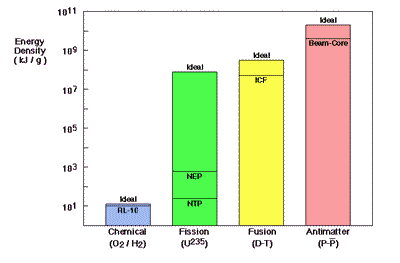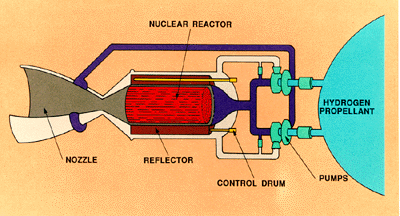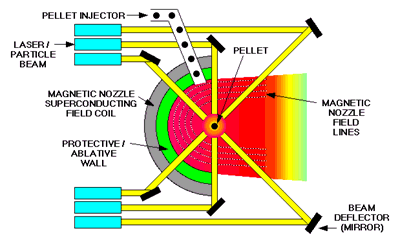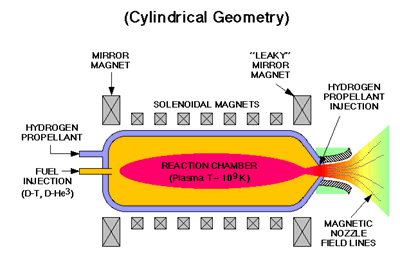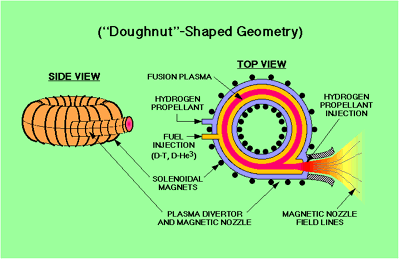Nuclear Thermal
If we truly desire to explore the Solar System, we should be working to develop nuclear propulsion technologies. Unfortunately, the worldwide anti-nuclear sentiment is likely to prevent any significant systems development and testing in the near future. Even the Cassini probe launch caused mass hysteria because of the plutonium contained in its radioisotope generators (RTGs).
It is certain; however, that the radiation created by nuclear technologies is dangerous to both humans and their machines. Any use of nuclear propulsion technology would have to be accompanied by the use of extensive shielding and "hardening."
It is arguable that the benefits outweigh the potential dangers inherent in nuclear technologies. However, one should remember that there are many Navy vessels plying the world's oceans that contain much more dangerous nuclear materials, both in their power reactors and their nuclear arsenals. I lived aboard one such vessel for four years without mishap, so I believe that the dangers are managable.
The potential advantages of nuclear propulsion over
chemical methods are staggering. It is estimated that the energy available
from nuclear reactions (fission, fusion, and matter-antimatter annihilation)
can range from 107 to 109
times that of chemical reactions, as shown in the graph below. (Frisbee,
2000i)
We will concentrate on the two forms of nuclear
propulsion most likely to be used in the (reasonably) near future-- fission
and fusion. Antimatter propulsion is extremely attractive; but is probably
more suited to interstellar propulsion. An excellent Web site that
discusses antimatter propulsion can be found
here.
Fission
The energy available from a unit mass of fissionable
material is approximately 107
times larger than that available from the most energetic chemical reactions.
A "typical" solid-core nuclear rocket engine utilizing fissionable material
is shown in the diagram below. In this engine, the propellant is heated as
it passes through a heat-generating solid fuel core (nuclear reactor).
Material constraints are a limiting factor in the performance of solid core nuclear rockets. The maximum operating temperature of the working fluid (e.g., hydrogen) must be less than the melting point of the fuel, moderator, and core structural materials. This corresponds to specific impulses of around 800 to 900 lbf-s/lbm. (Frisbee, 2000k)
In the late 1960s and early 1970s, the U.S. developed a nuclear rocket based on the concept drawing above. The fissionable material in the graphite fuel element was in the form of particles of uranium carbide coated with pyrolytic carbon. The engine that was developed as a result of this program was called NERVA (Nuclear Engine for Rocket Vehicle Application).
NERVA was designed to operate at 1500 MW, provide 333 kN of thrust at a specific impulse of 825 lbf-s/lbm, and have an engine weight of 10.4 metric tons. It was engineered for a ten-hour life and sixty operating cycles. (Frisbee, 2000k)
The NERVA engine was nearly completely developed when the project was terminated in 1972. Since then, there has been a limited amount of research done on fuels and materials, but they indicate that with modern materials and technologies, a NERVA-derivative engine could achieve an Isp in the 900 lbf-s/lbm range.
Fusion
There are two major methods for providing the confinement necessary to sustain a fusion reaction: inertial confinement fusion (ICF), and magnetic confinement fusion (MCF). These confinement schemes result in two very different propulsion system designs.
Inertial Confinement
ICF would use high-power lasers or particle beams to
compress a pellet of fusion fuel (typically deuterium-tritium, D-T), heating
it to fusion conditions. Functionally, this would work by placing the fuel
pellet at the focal point of several lasers or particle beams. Together,
they would compress and heat the pellet at the same time. Conforming to
Newton's Third Law, the compression of the pellet is balanced by an equal
and opposite outward explosion of the fuel pellet. Theoretically, the
pellet's own inertia would be enough to confine the plasma long enough to
achieve fusion. (Frisbee,
2000f)
Unfortunately, these systems needed to drive the ICF reaction are large, heavy and heavily dependant on electrical power. This makes ICF unattractive to near-term spacecraft design. Luckily, there is another option for fusion propulsion.
Magnetic Confinement
While an inertial
confinement fusion (ICF) would use lasers or particle beams to achieve
fusion, a magnetic confinement fusion (MCF) might achieve fusion by
confining plasma with strong magnetic fields. This should be possible, since
the fusion plasma is composed primarily of ions and electrons that are
susceptible to magnetic forces. The fusion plasma is carried to the magnetic
nozzle by magnetic fields inside the reactor. Mixing a propellant such as
hydrogen to the plasma reduces the specific impulse and increases the thrust
level.
The most common configuration considered for
MCF propulsion systems is the "tandem mirror" system shown in the schematic
below. This system uses magnets to confine the plasma, with two magnetic "mirrors"
for to confine the plasma at each end. One mirror is made slightly weaker ("leaky"),
which permits some of the plasma to escape, producing propulsive thrust.
While recent estimates for this system suggest performance similar to ICF
systems, tandem mirror system is very long (~.5 km), maximizing plasma
residence time. (Frisbee,
2000g)
TANDEM MIRROR
One alternative approach to the tandem mirror,
devised by Robert Bussard, is called the "Tokamak." It would use a doughnut-shaped
configuration with a plasma diverter in order to greatly reduce the size of
the reactor.
TOKAMAK
While NERVA-derived engines could possibly achieve an Isp
in the range of 900 lbf-s/lbm, fusion engines promise
an ideal Isp of 108 times that of chemical fuel.
Given that LH2/LOX has an Isp of 423 lbf-s/lbm,
this would yield an approximate Isp of 4.23 x 1010.
Adding hydrogen to the fusion products would reduce the Isp to
about 4000 lbf-s/lbm.
Although nuclear thermal propulsion systems have a great potential for interplanetary propulsion systems, the drawbacks (political, environmental, and physical) will most likely prevent us from developing these technologies in the near future.
Alıntı: http://www.ucar.edu/eo/staff/dward/sao/fit/nuclear.htm
Hiçbir yazı/ resim izinsiz olarak kullanılamaz!! Telif hakları uyarınca bu bir suçtur..! Tüm hakları Çetin BAL' a aittir. Kaynak gösterilmek şartıyla siteden alıntı yapılabilir.
The Time Machine Project © 2005 Cetin BAL - GSM:+90 05366063183 -Turkiye/Denizli
Ana Sayfa /İndex /Roket bilimi / ![]() E-Mail /CetinBAL /Quantum Teleportation-2
E-Mail /CetinBAL /Quantum Teleportation-2
Time Travel Technology /Ziyaretçi Defteri / Duyuru / UFO Technology
